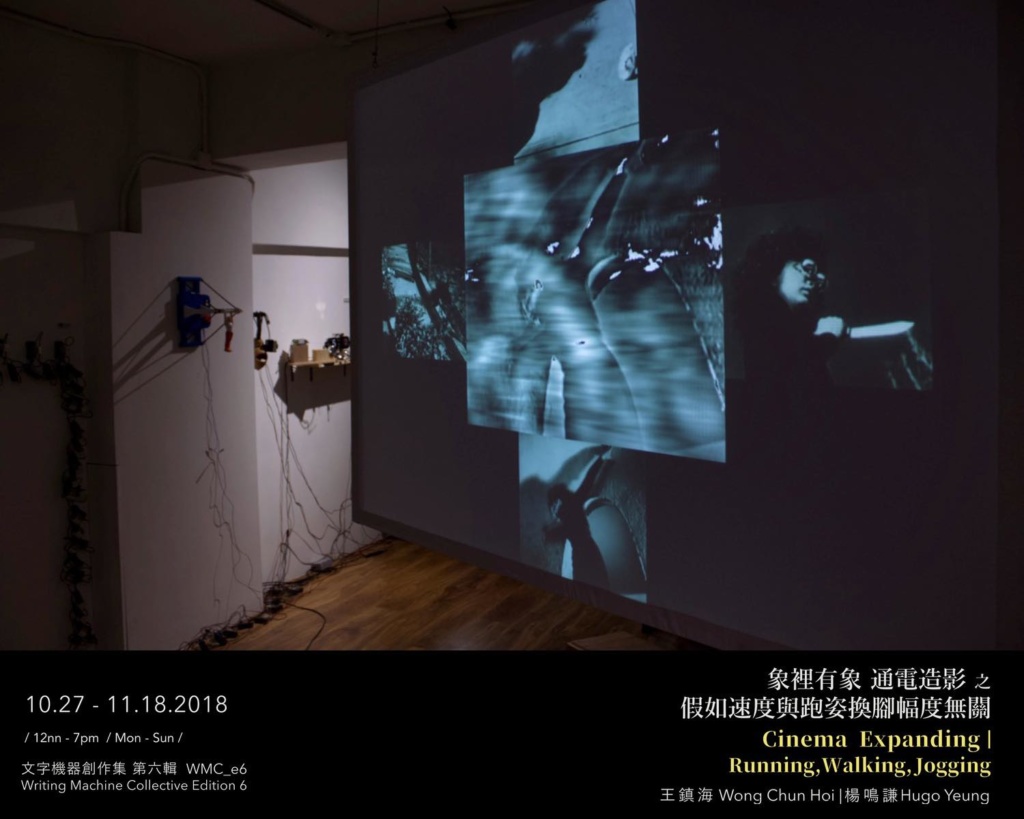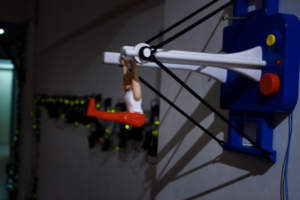wmc_e6 2018.11.04 | immediate release 即時發佈 | Bryan Chung in conversation with Hugo Yeung and Wong Chun-hoi in “Spatialized Cinema” 3:00-4:00pm at ACO Bookstore, 14/F, Foo Tak Building, 365-367 Hennessy Road, Wanchai | 藝術家講座-《流動於空間的活動影像》| 鍾緯正與展出藝術家王鎮海、楊鳴謙對談 | 11.4.2018 下午三時至四時 | 灣仔軒尼詩道365-367號富德樓14樓艺鵠書店 | exhibition on on 6/F until 2018.11.18 繼續於六樓開展直至2018.11.18 | Media Contacts: Tobias Tang (Exhibition Producer) Mobile: 65748872 傳媒聯絡:鄧志韜(展覽監製)| Email: writingmachinecollective.e6@gmail.com

The possibility of moving images is never restricted by the screen. Running, Walking, Jogging along the timeline with the same speed features two young artists, Wong Chun-hoi and Hugo Yeung Ming-him, each articulating their views on 21st century moving images. The event showcases two independent but connecting “video” installations, both revolving around the process of image-making, to explore the “raw materials” that “unfold” the micro elements of image discourses.
Wong Chun-hoi’s hardworking circuit #1.4 – A switched-on projector [work-in-progress] (2018)
A circuit physically functions as a sequence of successive on-off switches that form a domino structure. A bunch of switches, turned on sequentially in serial ordering, will “terminate” after turning on all electronic/everyday objects one by one. The selection of objects to be turned on the sequence is the key to discovering the playful artistic possibilities afforded by the timeframe generated by the circuit’s physical manifestation. Each iteration, ignited by pressing the “on” button, initiates a process comparable to a movie sequence unfolding in the form of x frames per second, like a micro narrative, whereby the audience study the causal drama of electricity dancing through within a set timeframe with a visible, spectacular process and a curious “denouement” [結局、終局].

The hardworking circuit series began in 2015 as experiments, published at Oil Street and the Floating Projects. hardworking circuit 1.3 has won the Gold Award, Media Art category in the ifva 2018 competition. Gao Shiqiang, one of the jurors, commented, “This artist attempts to delay the completion of the route from A to B, and makes something out of this clever idea. The root itself is very complicated, and reflects what our daily lives are about, that you often have to go through a lot of things before you get to the final destination.”
Hugo Yeung’s Harmonic Montage (2018)
Harmonic Montage is an ongoing exploration of an audio-visual algorithmic generative system that utilizes Discrete Fourier Transform (DFT), used also in the artist’s former computational cinema pieces What Death Tells M and UnSilent Cinema. This system was created to be a tool to invent and expand new aesthetic qualities of cinema by foregrounding lower-level data such as image pixels, audio waveform, temporal linearity and so on.
One of the main objectives of Harmonic Montage is to expand the definition of “editing” and to open up new ways to implement montage by deploying signal interference as a mediator between juxtaposed images. The work also allow participants to engage in the production of both the audio and visual elements using the system the artist custom-makes. In this way, the artist turns “montage,” which primarily means the juxtaposition and succession of images, into the spatialization of different visual-audio objects via a centric formation. A screen hangs in the central position of the venue showing interchangeably dominant images, suggesting the different sound sources that trigger different images. Sound sources are in fact sound-making objects lying around the venue, like musical instruments awaiting visitors to play them. Harmonic Montage is visitors’ collaborative reconstruction of Maya Deren’s Meshes of the Afternoon. (1943), a dream narrative now further disintegrates as visitors chance their interference through sound-making.
Harmonic Montage uses Discrete Fourier Transform, a family of algorithm, also used in his early works What Death Tells Me (2015) and UnSilent Cinema (2018), to explore the importance of sound in films. What Death Tells Me, for example, allows the soundtracks interfere with the visual elements. In the Jockey Club ifva Carnival, his commissioned artwork UnSilent Cinema creates visuals by the piano sounds audience “played” on the site. an experiment that Yeung carries on in Harmonic Montage. In this show, the sounds visitors create with the different “instruments” push certain prepared images from the periphery to the centre of the screen. This generative audio-visual piece also takes advantage of a flat screen space with multiple windows — i.e. 4 smaller windows surrounding the central window — to play the game of domination-recession based on audio input.
Both artists will attend the artists’ talk “Spatialized Cinema” on 4th November 2018, moderated by media artist Dr. Bryan Chung.

影像的可能性豈止於平面的熒幕之上?王鎮海、楊鳴謙兩位年青媒體藝術家聯手雙個展《假如速度與跑姿換腳幅度無關》,展示兩組截然不同卻相互緊扣的影像裝置創作,擺出他們的廿一世紀影像研究。兩組創作不約而同地實驗電影「造影」的過程,研究電影劇情之外的微敘事「原材料」。
王鎮海:《勤力電路1.4 ‒ 開著了的投影機 (持續創作)》(2018)
王鎮海的《勤力電路1.4 ‒ 開著了的投影機 (持續創作)》把交流電化作電影的素材。作品以多個繼電器串聯而成,骨牌式的接連啟動,直到沿途各個終端電器被開啟。開關按鈕開啟,數秒間近百個繼電器逐個啟動,近似傳統投影機每秒鐘運行24格菲林般,只是王的作品的「數秒」卻重新喚召訪者的好奇 – 到底「數秒」有多長?「數秒」所盛載的微細過程和精巧描述有甚麼可能?訪者觀看著電力飛舞間斷的座落於藝術家隨心設定的多個落點以至最後「終局」。王鎮海所安排的電「路」書寫著具時間性的流程,帶鮮明的起承轉合,是絕不苟且的微敘事。故事呢?就由觀者自行想像了。
《勤力電路》(2015)在油街和「據點。句點」開始實驗發表,漸進成持續的系列。《勤力電路1.3》曾獲2018年ifva比賽媒體藝術組金獎,其中評審高士強稱讚道:「(作品)把從起點到終點的過程不斷延遲,跟我們的生活經驗有一點的切合。他把過程延遲,就像電影中的特寫鏡頭,把這過程放大,形成特別深刻的意義。」
楊鳴謙:《諧波蒙太奇》(2018)
另一邊廂,楊鳴謙的《諧波蒙太奇》嘗試重置聲音在電影剪接的地位。裝置由一個投映及多件小型發聲物件組成,在觀眾使用物件發出聲音時,投映根據聲音頻率而剪接出相應片段的影像頻率到畫面中。在各種聲音的合奏下,投映由不同片段的局部影像頻率交織構成,成為由觀眾主動參與衍生成的聲影蒙太奇。
《諧波蒙太奇》與前作《死亡如是說》(2015) 及《有聲默片》(2018) 同樣利用「離散傅立葉變換」(Discrete Fourier Transform),分別探討聲音在電影中的重要性,《死亡如是說》透過電影配樂干擾影像;賽馬會ifva影像嘉年華委託創作《有聲默片》則讓觀眾透過現場「玩」鋼琴為電影「配樂」而催生影像。是次創作《諧波蒙太奇》把《有聲默片》推前一步,依然是以觀眾現場「造」聲去推動場館中央布幕上的框內蒙太奇。現場樂器隱約接連藝術家預先儲藏的片段音剪接影像,一時徘徊於外圍,一時成功進佔中央地帶,就靠賴所選的樂器、所造的聲頻。看似一場力氣改動空間的角力,從創作者而言,是衍生性藝術、膨脹錄像的體驗。
楊鳴謙所選的素材是美國實驗電影女藝術家 Maya Deren 的 Meshes of the Afternoon (1943)。原片的「夢」邏輯的敘事以「斷、碎」和時空上的失接創作了另一種「連續性」,設合了《諧波蒙太奇》的隨機換位,以平面上單位的近鄰性取代線性的排序。
兩名藝術家於11月4日亦會出席藝術家講座《流動於空間的活動影像》,與資深媒體藝術家鍾緯正博士對談。
